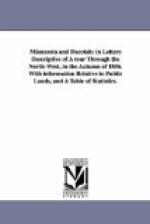I think I cannot do a better service to the emigrant or settler than to quote a part of the report made by Mr. A. W. Tinkham, descriptive of his route from St. Paul to Fort Union. His exploration, under Gov. Stevens, was made in the summer of 1853; and he has evidently given an impartial account of the country. I begin with it where he crosses the Mississippi in the vicinity of St. Cloud. The part quoted embraces the route for a distance of two hundred and ninety-five miles; the first seventy miles of which was due west— the rest of the route being a little north of west.
“June 9. Ferried across the Mississippi River, here some six hundred to eight hundred feet wide— boating the camp equipage, provisions, &c., and swimming the animals; through rich and fertile prairies, variegated with the wooded banks of Sauk River, a short distance on the left, with the wooded hills on either side, the clustered growth of elm, poplar, and oak, which the road occasionally touches; following the ‘Red River trail,’ we camp at Cold Spring Brook, with clear, cool water, good grass, and wood.
“June 10. Cold Spring Brook is a small brook about ten feet across, flowing through a miry slough, which is very soft and deep, and previous to the passage of the wagons, had, for about two hundred feet distance, been bridged in advance by a causeway of round or split logs of the poplar growth near by; between this and the crossing of Sauk River are two other bad sloughs, over one of which are laid logs of poplar, and over the other the wagons were hauled by hand, after first removing the loads. Sauk River is crossed obliquely with a length of ford some three hundred feet— depth of water four-and-a-half to five feet; goods must be boated or rafted over, the river woods affording the means of building a raft; camped immediately after crossing; wood, water, and grass good and abundant.
“June 11. Over rolling prairies, without wood on the trail, although generally in sight on the right or left, with occasional small ponds and several bad sloughs, across which the wagons were hauled over by hand to Lake Henry— a handsome, wooded lake; good wood and grass; water from small pond; not very good.
“June 13. Passing over rolling prairies to a branch of Crow River, the channel of which is only some twenty feet wide and four or five feet deep; but the water makes back into the grass one hundred feet or more from the channel as early in the season as when crossed by the train. Goods boated over; wagons by hand and with ropes; no wood on the stream; several small lakes, not wooded, are on either side of the trail, with many ducks, geese, and plovers on them: encamp at Lightning Lake, a small and pretty lake, sufficiently well wooded on the borders for camping purposes; good water, wood, and grass, and abounding with fish.
“June 18. Over rolling prairie with small pools and marshes, to a swift running stream about twenty feet wide, three feet deep, a branch of Chippewa River; heavily rolling ground with stony knolls and granite boulders, to White Bear Lake, a large handsome lake, with mingled open and woodland.




